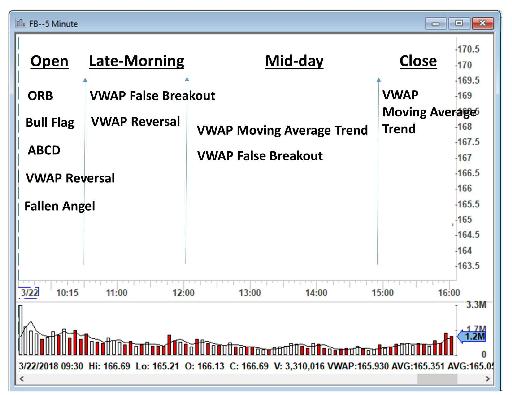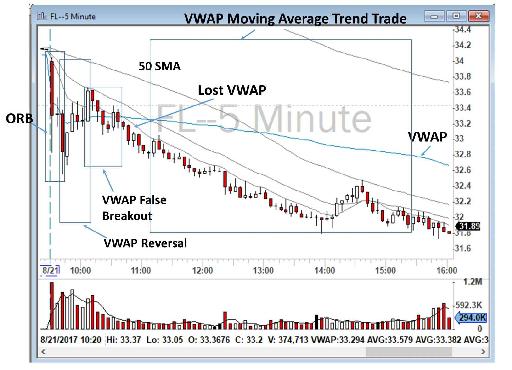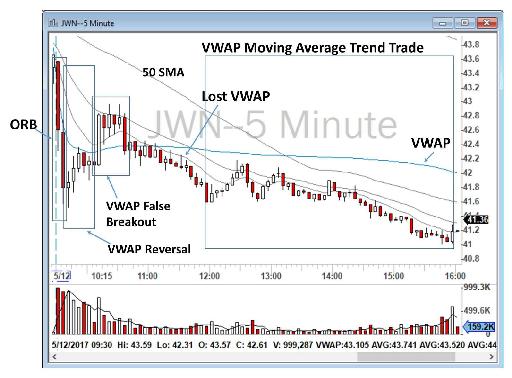One Stock in Play, All Strategies
I categorize day trading sessions based upon the time of day: the Open, Late-Morning, Mid-day, and the Close. Each time period should be treated differently, and you have to be careful because not all strategies are effective in every time period. Good traders make note of what time of day their most profitable trades occur and adjust their trading and strategies to fit such times.
The Open tends to last about 30 to 60 minutes (from 9:30 up to 10:30 a.m. New York time).
- Bull Flag, ORB, ABCD, VWAP Reversals and Fallen Angel tend to be the best strategies for the Open.
During the Late-Morning (10:30 a.m. to 12 p.m.), the market is slower but there is still good volatility in the Stocks in Play. This is one of the easiest times of the day for new traders. There is less volume compared to the Open but also less unexpected volatility. A review of my new traders’ trades indicates that they do the worst during the Open and best during the Late-Morning session. Especially excellent risk/reward trades can be expected during this period.
- VWAP Reversal and VWAP False Breakout tend to be the best strategies for the Late-Morning. I rarely trade Bull Flag in the Late-Morning, Mid-day or at the Close.
During the Mid-day (12 p.m. to 3 p.m.) the market is slower. There is less volume and volatility, but Stocks in Play will often start finding their trend to the upside or downside.
- VWAP Moving Average Trend and VWAP False Breakout tend to be the best strategies for the Mid-day. Wait to see if the Stocks in Play hold the VWAP or lose it before trading based on the VWAP Moving Average Trend Strategy.
Into the Close (3 to 4 p.m.), stocks are more directional, so I stick with those that are trending up or down in the last hour of the trading day. I raise my tier size from the Mid-day, but not as high as it is at the Open. The daily closing prices tend to reflect the opinion of Wall Street traders on the value of stocks. They watch the markets throughout the day and tend to dominate the last hour of trading. Many of the market professionals take profits at that time to avoid carrying trades overnight. If the stock is moving higher in the last hour, it means the professionals are probably bullish on that stock. If the stock is moving lower in the last hour, the market professionals are probably bearish. It is thus a good idea to trade with the professionals and not against them.
- VWAP Moving Average Trend trades tend to be the best strategies for the Close.
Many traders lose during the day what they have profited in the Open. Don’t be one of them. I created a rule for myself. I am not allowed to lose more than 30% of what I have made in the Open during the Late-Morning, the Mid-day and the Close. If I lose more than the allowed 30%, then I either stop trading or start trading in a simulator.
This is just a general guideline to what normally happens at these times. And sometimes, many of them can even happen at the same time. Some examples follow this Figure 6.57, which is a summary chart of various trading strategies organized by the time of day that I recommend they be utilized.

Figure 6.57 - Recommended trading strategies organized by the time of day.
Figure 6.58 shows FL on August 21, 2017. This stock did a really nice Opening Range Breakout, then it did a VWAP False Breakout, and then it started a VWAP Moving Average Trend to the downside. Thus, this stock showed three strategies in just this one time interval. Some people might also have taken a reversal right at the Open. So, as you can see, there are a number of strategies that can happen together at the same time.

Figure 6.58 - Example of how several strategies can unfold in one Stock in Play (in this instance FL).
Another example is Figure 6.59, JWN on May 12, 2017. Again, as you can see, one Stock in Play showed several strategies all at once. The stock had a very nice Opening Range Breakout, then a really nice VWAP False Breakout, and then it started to establish a downtrend. If you had wanted to take a reversal, you could have done that to the VWAP at around 9:45 a.m.

Figure 6.59 - Example of how several strategies can unfold in one Stock in Play (in this instance JWN).
Table of contents
- DISCLAIMER:
- Table of Contents
- Chapter 1: Introduction
- Chapter 2: The Trading Tools and Platform
- Chapter 3: Building Your Trading Watchlist
- Chapter 4: Support and Resistance Levels
- Chapter 5: Price Action, Candlesticks and Trade Management
- Chapter 6: Advanced Day Trading Strategies
- Chapter 7: Risk and Account Management
- Chapter 8: Conclusion and Final Words
- Glossary